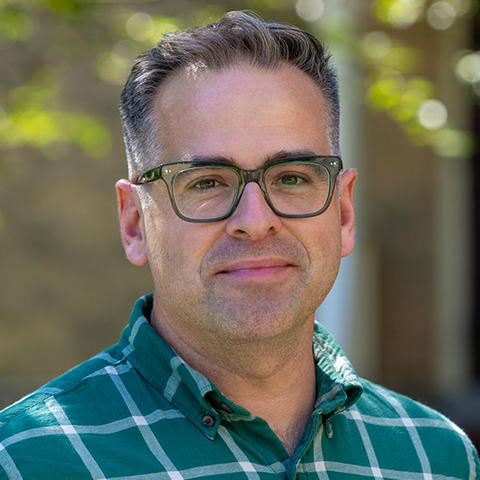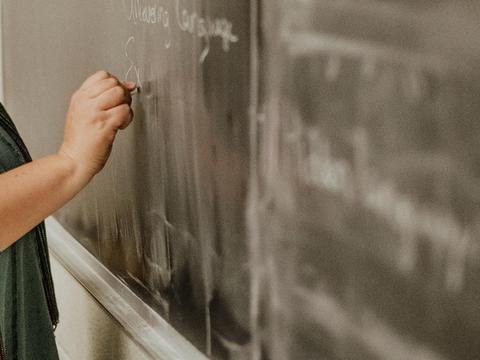Faculty Focus: Professor of Chemistry Alex Norquist

Photo by Patrick Montero.
Details
A solid state chemist, Norquist seeks out new solids with unique and useful properties. Assisted by robots and artificial intelligence, his lab’s current work is designed to help in the fight against climate change.
As winter begins to give way to spring, stacks of Girl Scout cookies materialize in Professor of Chemistry Alex Norquist’s office. The sweet treats are nourishment for the students who seek out Norquist for his mentorship and unbridled enthusiasm for chemistry, which at Haverford, he says, “is a team sport.”
“I was driving home and stopped by the hardware store, and a few Girl Scouts were outside the entrance selling them,” Norquist says, referring to the numerous cartons of cookies on the floor of his office in the Marian E. Koshland Integrated Natural Sciences Center. Given that each contains 12 packages of Thin Mints, Peanut Butter Patties, and the like, there’s little doubt that Norquist sent those scouts home happy campers and much closer to reaching their sales goals.
Perhaps there’s a compelling allegory to be found in the space between the Girl Scouts’ willingness to experiment and introduce new flavor combinations and Norquist’s scientific pursuit of new solids with useful and innovative properties. Or maybe it’s a much simpler matter of the cookies supplying a much-needed boost for the students who seem determined to spend as much time in his lab as possible. Regardless of their nutritional needs, those students are a constant presence, Norquist says, because of Haverford’s continued support of great scientific facilities, robust summer experiences, and, of course, his work.
“I have 12 students who work in my lab. Some of them are seniors and they’re in the lab a lot. Some of them are younger students who are in the lab less. That takes time and resources, and the College is very supportive of that,” Norquist says. “Every summer, I have between three and five students in my lab all day long, every day, for the first 10 weeks of summer. So the lab is a pretty busy place until August. That only comes through institutional support.”
Norquist, who marks 21 years of teaching at Haverford this year, describes himself as a “solid state chemist who does a lot of exploratory work.” Simply put, he’s a scientist who is most interested in plumbing the depths of chemical space that has yet to be explored well, if at all.
“I like to make things,” he says. “But I've never been focused on chasing properties, I’m not trying to optimize or make the next best anything. I'm taking a more fundamental approach to see if we can understand how whole classes of materials form and why they form under the conditions that they do. And that sort of knowledge can be applied to a wide range of systems.”
Many of those “things” arise from the continued exploration of low-symmetry materials in his lab. Symmetry is prevalent in things like minerals and crystals but, he says, when scientists are able to prohibit certain types of symmetrical elements, they open the door to a wide range of physical properties. As an everyday example, Norquist points to the standard computer hard drive, which relies on a small magnetic field to cause the physical distortion necessary for information to be stored in binary as ones and zeros. Or think of a laser pointer, where the wavelength of an invisible infrared laser is altered as it passes through a potassium titanyl phosphate crystal, creating the beam we use to emphasize our PowerPoint presentations.
More recently, through funding from DARPA, Norquist’s attention shifted from metal oxide compounds to an emergent class of materials called metal halide perovskites, which, as the world strives to increase renewable energy, have real potential for use in photovoltaic cells. They may not be as adept at capturing sunlight as standard crystalline silicon solar panels, which, Norquist says, work quite well and have been “engineered to death over the past 50 years,” but the material is much cheaper to produce.
Norquist’s growing interest in sustainability and renewable energy is a direct result of the influence of his students, he says, who bring with them to Haverford an increased urgency surrounding the existential threat and impacts of climate change. “Climate change is the grand challenge for this young generation. They are already experiencing the undeniable effects associated with it,” Norquist says. “This is a huge problem that we have to tackle.”
While metal halide perovskites show a lot of promise, there are still numerous open questions surrounding them. In the search for answers, Norquist has turned to robots and emerging machine learning techniques to examine the chemical reactions that have occurred in his Haverford lab for the past two decades, especially those that have failed. His earlier work and collaborations in this arena with Shibulal Family Computer Science Professor Sorelle Friedler and former Associate Professor of Chemistry Joshua Schrier, who is now at Fordham University, were the subject of a 2016 Nature cover story.
The paper they published, which has six Haverford alums as coauthors, highlights the importance of “dark reactions” and the model they developed that predicts reaction successes or failures with greater accuracy than human intuition alone. In some ways, the paper is a cautionary tale, Norquist says.
“If you’re trying to model something and you only give it positive results, the models will think that everything is going to work. If you’re trying to model a sidewalk, but you don't tell the model that curbs exist, it’ll think that the sidewalk goes on forever,” he says. “In the context of chemistry, if we don’t address failure bias we'll never be able to understand what the boundaries are. And it’s the boundary between success and failure that’s most interesting.”
Norquist likens the burgeoning use of artificial intelligence in his lab to the mere evolution of the tools available to scientists. First came the slide rule, and then the calculator, he says. Now there are large language models like ChatGPT. “AI models can streamline and wildly increase the rate that we can extract information from papers,” Norquist says. “They can read more papers than we can, and they can extract data in a much better way. AI is going to blow the doors off of science.”
AI is not without its pitfalls, Norquist admits, but he firmly believes that his students must be trained on how to interact with it effectively, whether that means learning how to write effective prompts or using robots to run reactions. Whatever the case, he says, the age of generative AI and machine learning will help scientists break away from any inherent human biases or propensity for defaulting to running the same types of experiments over and over.
“From the knowledge aspect, AI is revolutionary. But I'm going to keep my science hat on and use it to make science better, faster, more effective, and more efficient,” Norquist says. “I'm going to let somebody else worry about killer robots. My robot has no arms and no legs. It can't turn evil. All it does is dispense liquids very quickly.”




